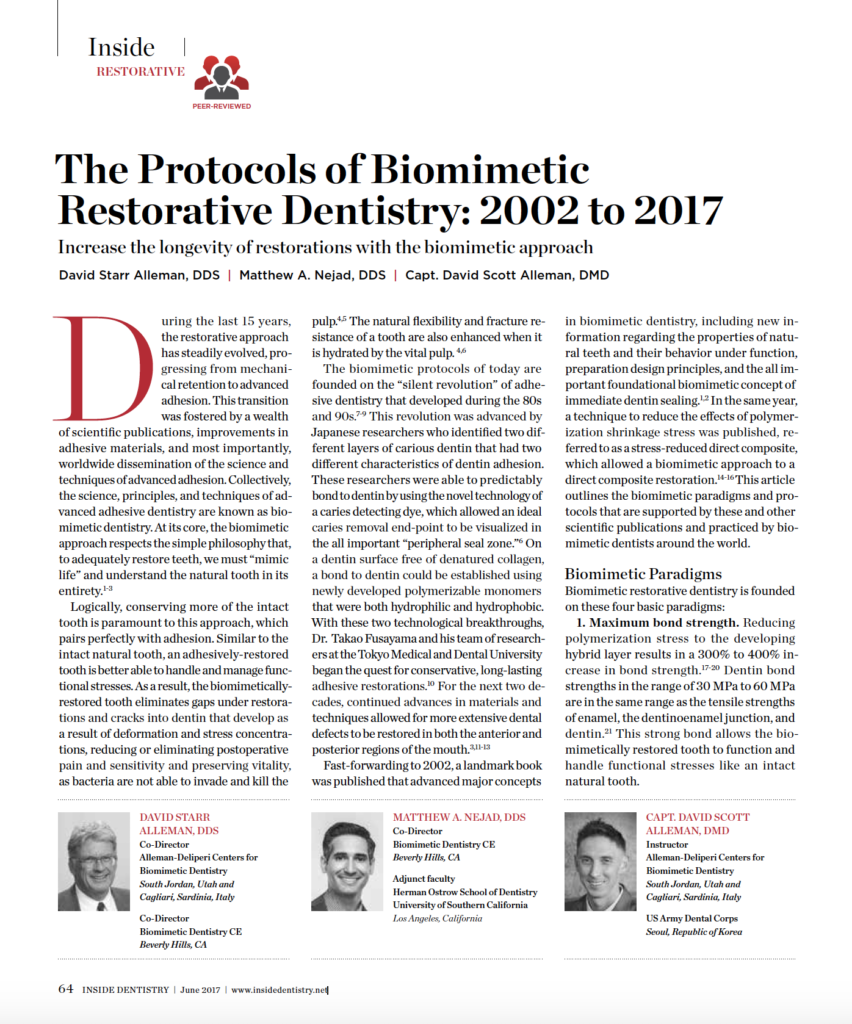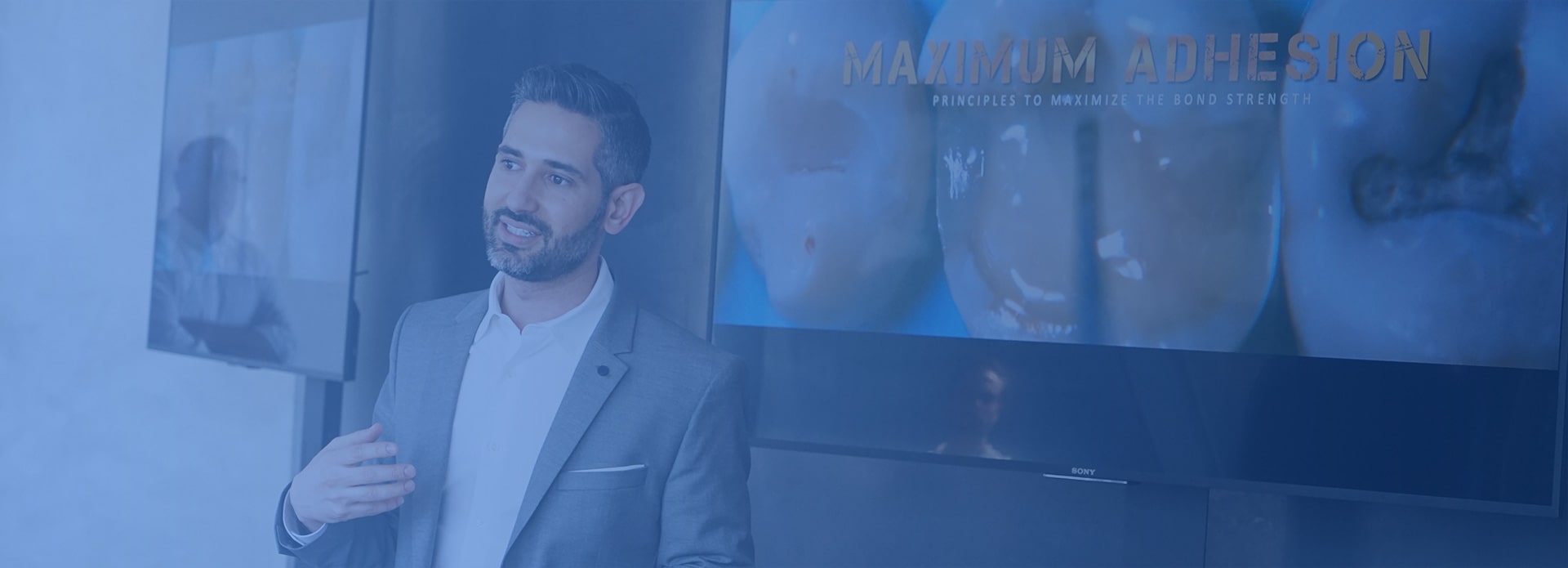
Biomimetic Dentistry
Biomimetics noun
bio·mi·met·ics | \ ˌbī-ō-mə-ˈme-tiks
The study of the formation, structure, or function of biologically produced substances and materials for the purpose of synthesizing similar products by artificial mechanisms which mimic natural ones.
Biomimetic Dentistry
Biomimetic dentistry is the practice of dentistry which applies the concept of Biomimetics. This treatment approach strives to preserve intact tooth structure and restore the function and biomechanics of natural teeth. Biomimetic dentistry is typically applied to restorative and esthetic dentistry, but it can be applied to any dental discipline.
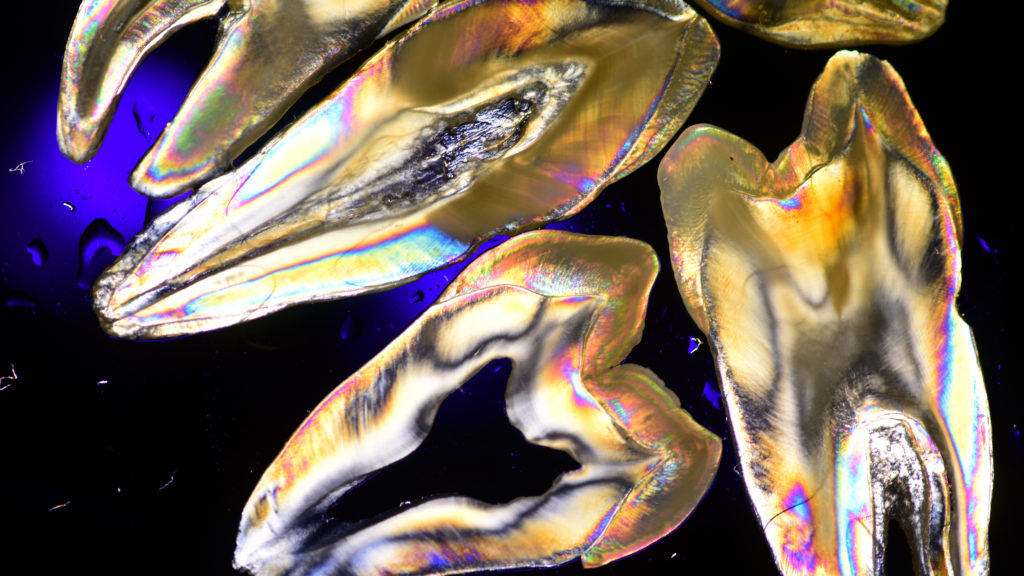
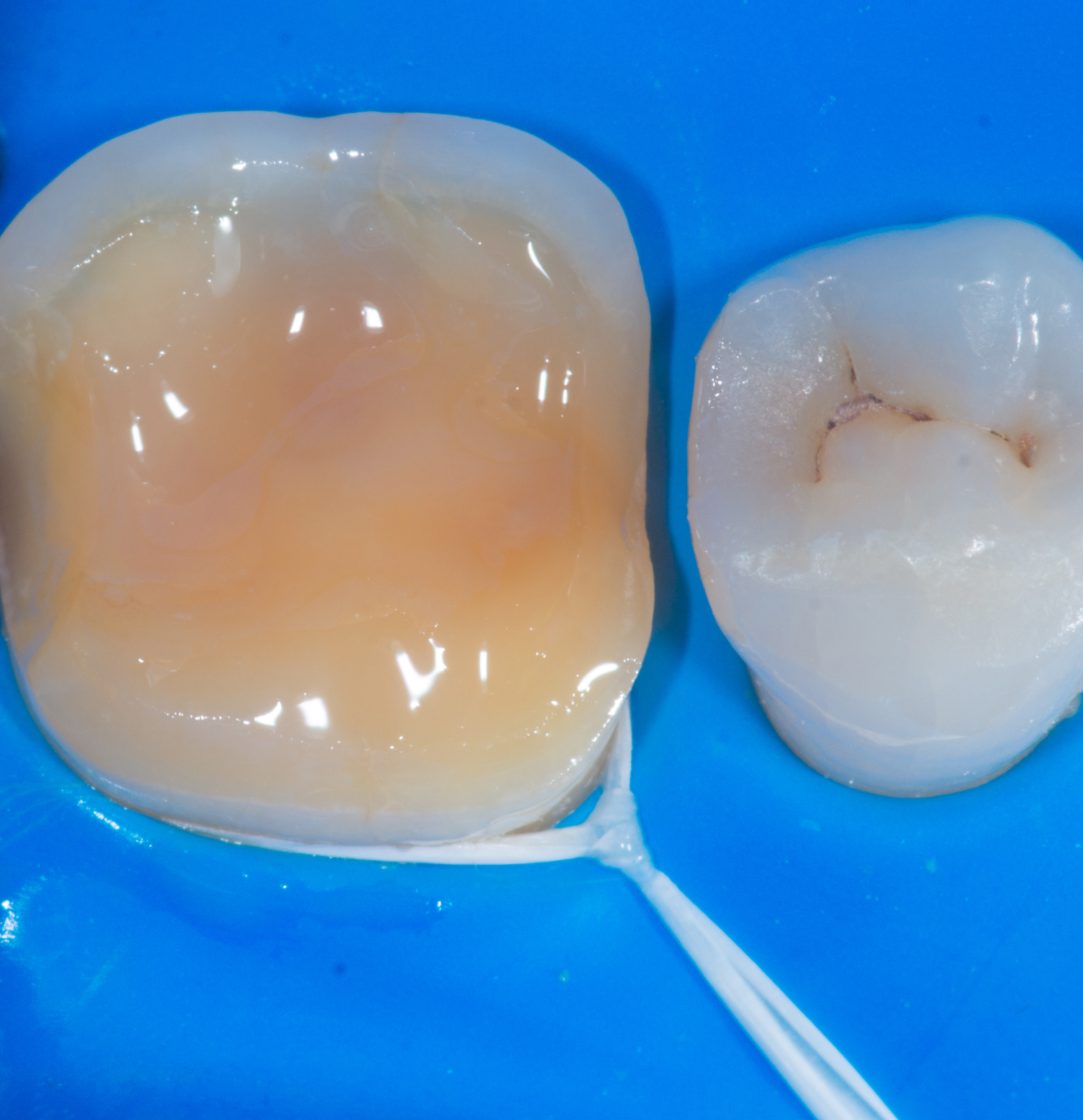
History
Biomimetic dentistry has been developing gradually over many decades, gaining momentum with advances in adhesive dentistry, dental materials, and cariology. Adhesive dentistry has its beginnings in 1955 when Dr. Michael Buonocore published a groundbreaking paper on the acid-etch technique, in which he states: “A filling material capable of forming strong bonds to tooth structures would offer many advantages over present ones. With such a material, there would be no need for retention and resistance form in cavity preparation…”. These words would be the beginning of an “adhesive revolution” in which further advances in adhesive dentistry would gradually replace traditional techniques which require more removal and destruction of intact tooth structure. Additional advancements in restorative materials and caries removal would contribute to techniques, which minimize tooth preparation and maximize pulp vitality.
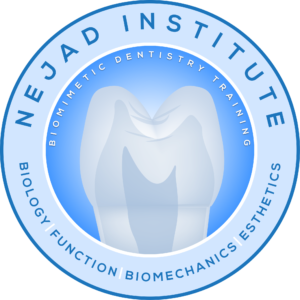
Core Philosophies
Biomimetic Dentistry emphasizes preserving and mimicking the various properties of natural teeth.
The preparation and restorative techniques preserve natural tooth structure and pulp vitality. Restorative materials replicate the function of natural enamel, dentin, and DEJ and the restored tooth is biomechanically and esthetically similar to natural teeth.
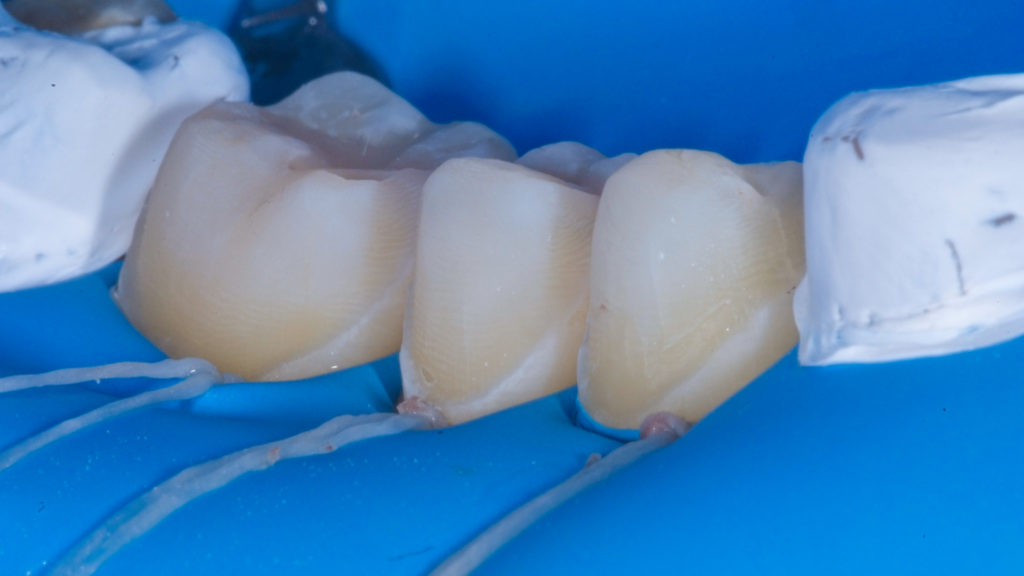
Important Concepts
Biomimetic Approach
- Preserve Intact Tooth Structure
- Maximize Adhesion
- Minimize Residual Stress
- Restore Structural Integrity
- Replicate Natural Biomechanics
- Caries Removal Endpoints
- Preparation Design
- Restorative Materials which are Biomimetic
Biomimetic Dentistry vs Traditional Dentistry
Traditional dental procedures rely on preparation designs that accommodate the restorative material or technique. This includes preparation features such as retention and resistance form, as well as tooth reduction to meet the strength requirements of the restorative material instead of prioritizing the preservation of intact tooth structure. As a result, the restored tooth has significant additional preparation and a significantly higher chance of complications such as pain, sensitivity, root canal treatment, recession, and fracture. Examples of such dental procedures include full coverage crowns (zirconia, porcelain fused to metal, gold) and a variety of metallic inlays and fillings (amalgam, glass ionomer).
In contrast, the Biomimetic approach unites an understanding and appreciation of the biomechanics of natural teeth with principles and techniques which maximize adhesion. These concepts comprise the necessary components to mimic the natural tooth most faithfully. Restorative materials replicate the properties of the dental structures and healthy intact tooth structure is preserved through adhesion without additional preparation requirements. The biomimetically restored tooth mimics the strength, function, and esthetics of natural teeth. Biomimetic restorations include composite fillings, partial coverage restorations, and when necessary, full-coverage ceramic restorations. However, the application technique and material selection makes a significant difference in the performance of these techniques and, therefore, it is important to have a sound understanding of the science.
Biomimetic Training
Biomimetic dental concepts have been growing in popularity, supported by a strong foundation of scientific evidence and clinical success. Dental schools worldwide have been adopting these advancements gradually. However, some leading dental schools, such as the University of Southern California (USC), have embraced Biomimetic dentistry with strong faculty support and academic research departments that are at the forefront of biomimetic dental concepts. Dentists with more traditional training have been trained in Biomimetic Dentistry through educators such as Dr. Nejad.
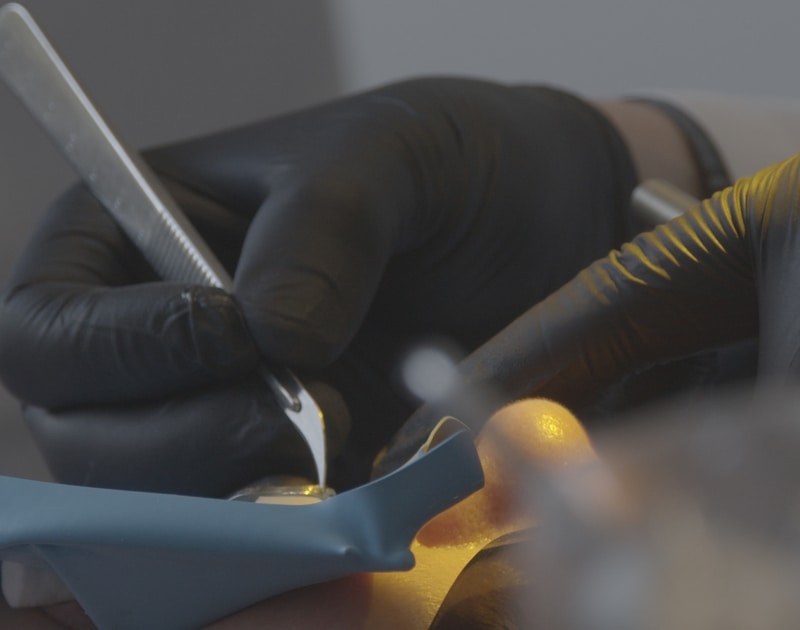
Advantages of Biomimetic Dentistry
- Preserve intact tooth structure
- Minimize pain and sensitivity
- Eliminate unnecessary root canals
- Restore teeth with limited remaining structure
- Optimal seal
- Prevent catastrophic failures
- Maximize adhesion by up to 400%
Frequently Asked Questions
Translated literally, Bio-mimetic dentistry means “imitate life (Bio=”life, mimetic=”imitate”). Biomimetic dentistry is a paradigm and not a specific material or a technique. The natural tooth is the perfect structure as a result of its various properties including biology, function, esthetics, and biomechanics. In the Biomimetic approach, optimal restorative materials and techniques “mimic” these properties of natural teeth and strive to preserve pulp vitality by conserving maximum intact tooth structure.
Traditional dental techniques rely on mechanical retention. As a result, more tooth preparation is required and the resulting structure does not function like a natural tooth. Stress concentration patterns, mechanical properties, and function of the mechanically restored tooth is nothing like the natural tooth. As a result, margins are not adequately sealed, cracks develop from harmful stress patterns, and the teeth experience a significantly higher chance of pain, sensitivity, bacterial invasion, and loss of pulp vitality.
Not exactly, however adhesive dentistry is fundamental to biomimetic dentistry. Biomimetic dentistry requires, materials which have properties similar to enamel, dentin, and DEJ in conjunction with the absolute maximum adhesion and bond strength. In the natural tooth, enamel and dentin have an extremely high bond strength and this needs to be re-created for a restored tooth to function like a natural tooth. Simplified adhesive techniques and inferior materials fail to adequately restore the tooth to the standard necessary to be considered biomimetic. Only the best and strongest adhesion is able to make a tooth behave biomimetically.
There are countless advantages obtained through biomimetic dentistry including:
- increases the bond strength by 400%
- preserve tooth structure with minimally invasive treatment approaches
- minimize excessive preparation of teeth for crowns
- minimize root canal treatments by 90-95%
- prevent catastrophic failures
- eliminate post-op pain and sensitivity
- restore badly damaged teeth, otherwise considered un-restorable
The principles of biomimetic dentistry were developed by researchers at prestigious universities in Japan, Sweden, Switzerland, The Netherlands, Italy, Turkey, The United States, and many other countries. Groundbreaking work by many top researchers in adhesive dentistry and restorative dentistry has contributed to the concepts and techniques which make up biomimetic dentistry. Officially, the first mention of “biomimetics” in the field dentistry is credited to Pascal Magne who really innovated the biomimetic dentistry concept and the biomimetic approach to restorative dentistry. Pascal authored the first textbook explaining the concepts of Biomimetic Dentistry (“Bonded Porcelain Restorations in the Anterior Dentition. A Biomimetic Approach.”) and he is regarded the as the father of biomimetic dentistry. Matt Nejad was trained by Pascal Magne and continues to work closely with Pascal Magne advancing concepts and techniques in biomimetic dentistry.
Not always, but typically yes. Treatment time varies from one operator to another, however the best treatment typically takes more time. Biomimetic restorations require good isolation, as well as careful caries removal concepts, and special adhesive application techniques which all can increase the treatment time. However, biomimetic restorations typically last far longer than traditional restorations and experience less complications and symptoms.
Biomimetic Dentistry is natural, holistic, and biologically favorable. The emphasis for biomimetic dentistry is on scientifically proven materials and techniques. Adhesion Science and Biomimetic Dentistry both have an extremely robust scientific foundation. Materials and techniques are based on scientific evidence that they perform most similar to the natural tooth, and maximize the longevity and vitality of natural teeth. When a Biomimetictally restored tooth is functionally and biomechanically similar to the natural tooth, complications are minimized and more invasive treatments such as root canals and implants can be avoided.
Adhesively retained restorations allow maximum preservation of intact tooth structure and frequently allow teeth to be restored without root canal treatment. Preserving pulp-vitality of the tooth is the most biologically profound treatment objective possible, resulting in the best long term success and the most natural biomechanics and function.
Traditional restorative techniques require tooth preparation to allow for retention and strength of the final restoration. Additionally, caries removal endpoints are subjective and often times excessively aggressive. This combination results a high incidence of root canals for restored teeth, either immediately or over the life of the traditionally restored tooth.
In contrast, the biomimetic approach has scientifically proven caries removal endpoints and preparation design principles that maximize preservation of the remaining tooth structure and avoiding pulp-exposures. Preserving more tooth structure, and avoiding pulp-exposures significantly decreases the necessity for root canals. Even with deep-caries, the chance of preserving pulp-vitality is high if: 1) the tooth is currently vital 2) a pulp-exposure is avoided and 3) the final restoration has a strong bond/seal.
The Academy of Biomimetic Dentistry is the group that is interested in promoting the practice and techniques of Biomimetic Dentistry. The group has been raising awareness of these concepts and techniques and this has helped educate both patients and dentists in the benefits of Biomimetic Dentistry. Dr. Nejad has been actively involved in the Academy, frequently lecturing and teaching courses for members and attendees. He is also on the scientific committee and accreditation committee of the Academy.
Biomimetic Dentistry is synonymous with high-quality dentistry. High-quality dentistry usually costs more, but sometimes even high priced dentistry does not equate to high-quality. The major reason Biomimetic Dentistry would cost more is due to the increased treatment time it takes to restore a tooth optimally.
